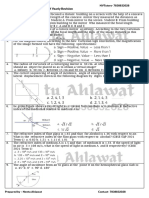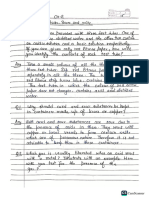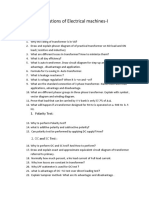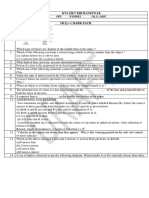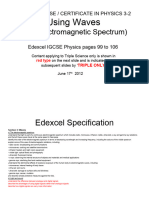0 ratings0% found this document useful (0 votes)
6 viewsChapter 9
Notes and Summary ncert class 10 ch 9
Uploaded by
Rajneesh MuthaCopyright
© © All Rights Reserved
Available Formats
Download as PDF, TXT or read online on Scribd
0 ratings0% found this document useful (0 votes)
6 viewsChapter 9
Notes and Summary ncert class 10 ch 9
Uploaded by
Rajneesh MuthaCopyright
© © All Rights Reserved
Available Formats
Download as PDF, TXT or read online on Scribd
You are on page 1/ 2
MAYOOR CHOPASNI SCHOOL, JODHPUR
Physics (042)/ X/ Worksheet/ Chapter: 9/ Light-Reflection and
Refraction
------------------------------------------------------------------------
1. For the same angle of incidence of 450, the refraction angle in two transparent
medium P and Q is 200 and 300 respectively. Which of the two is optically
denser and why?
2. Draw a labeled ray diagram to show the path of a ray of light incident
obliquely on one face of a glass slab.
3. Calculate the refractive index of the material of a glass slab. Given that the
speed of through the glass slab is 2 x 108m/s and in air 3 x 108m/s.
4. A lens produces a magnification of -0.5. Is this a converging or diverging
lens? If the focal length of the lens is 6cm, draw a ray diagram showing the
image formation in this case.
5. Show diagrammatically, how two converging lenses should be arranged so
that a parallel beam becomes parallel after passing through two lenses.
6. The linear magnification produced by a spherical mirror is +3. Analyses this
value and state the (i) type of mirror (ii) position of the object with respect to
the pole of the mirror. Draw ray diagram to show the formation of image in
this case.
7. Distinguish between real image and virtual image.
8. Distinguish between a convex lens and a concave lens.
9. A man is holding a lighted candle in front of a thick glass mirror and on
viewing it obliquely he noticed a number of images of the candle. Why?
10. Draw a labelled ray diagram to show the path of the reflected ray
corresponding to the ray which is directed towards the principal of a convex
mirror. Mark the angle of incidence and angle of reflection on it.
11. A student focuses the image of a candle flame, placed at about 2m from a
convex lens of focal length 10cm, on a screen. After that he moves gradually
the flame towards the lens and each time focuses its image on the screen.
(i) In which direction does he move the lens to focus the flame on the
screen?
(ii) What happens to the size of the image of the flame formed on the screen?
(iii) What difference is seen in the intensity (brightness) of the image of the
flame on the screen?
(iv) What is seen on the screen when the flame is very close about 5cm to
the lens?
12. An object is placed in front of a concave mirror of focal length 12cm. If
distance of the object from the poles the mirror is 8cm, then use mirror formula
to determine the position of the image formed. Draw a labelled ray diagram to
justify your answer in this case.
13. State Snell’s law of refraction of light. When a ray of light travelling in air
enters obliquely into a glass slab, it is observed that the light ray emerges
parallel to the incident ray but it is shifted sideways slightly. Draw a labelled
ray diagram to illustrate it.
14. What is meant by power of a lens? Write its SI unit. A student uses a lens of
focal length 40cm and another of -20cm. Write the nature and power of each
lens.
15. A security mirror used in a big showroom has radius of curvature 5m. If a
customer is standing at a distance of 20m from the cash counter find the
position, nature and size of the image formed in the security mirror.
16. Neha visited a dentist in his clinic. She observed that the dentist was holding
an instrument fitted with a mirror. State the nature of this mirror and reason for
its use in the instrument used by dentist.
17. A concave mirror of focal length 10cm can produce a magnified real as well
as virtual image of an object placed in front of it. Draw ray diagrams to justify
this statement.
18. An object is placed perpendicular to the principal axis of a convex mirror of
focal length 10cm. The distance of the object from the pole of the mirror is
10cm. Find the position of the image formed.
19. The image formed by a spherical mirror is real, inverted and is of magnification
-2. If the image is at a distance of 30cm from the mirror, where is the object
placed? Find the focal length of the mirror. List two characteristics of the image
formed if the object is moved 10cm towards the mirror.
20. A 2cm high object is placed at a distance of 32cm from a concave mirror. The
image is real, inverted and 3cm in size. Find the focal length of the mirror and
the position where the image if formed?
Prepared By: Dr. Shailndra Singh (PGT-Physics)
You might also like
- Hydrogen Atom PHET Simulation (Unit 2.6) Prelab QuestionsNo ratings yetHydrogen Atom PHET Simulation (Unit 2.6) Prelab Questions2 pages
- 9TH - Icse - Physics - Worksheet - Reflection of Light 2100% (9)9TH - Icse - Physics - Worksheet - Reflection of Light 25 pages
- Light - Reflection and Refraction: Questions To PracticeNo ratings yetLight - Reflection and Refraction: Questions To Practice4 pages
- Class X - Physics-Light Reflection and Refraction-Aecs2 MumbaiNo ratings yetClass X - Physics-Light Reflection and Refraction-Aecs2 Mumbai5 pages
- CH. LIGHT-MLP - 2 (2023-24) (To Take Printout For Class Discussion)No ratings yetCH. LIGHT-MLP - 2 (2023-24) (To Take Printout For Class Discussion)2 pages
- CBSE-Class-10-Science---Reflection---Refraction-Of-Light-assignment_1722156643654 (1)No ratings yetCBSE-Class-10-Science---Reflection---Refraction-Of-Light-assignment_1722156643654 (1)6 pages
- Light Reflection and Refraction Question BankNo ratings yetLight Reflection and Refraction Question Bank14 pages
- Reflection & Refraction of Light (Revision Questions) : Very Short Answer Type (1 Mark)No ratings yetReflection & Refraction of Light (Revision Questions) : Very Short Answer Type (1 Mark)10 pages
- CLASS X - PHYSICS-LIGHT REFLECTION AND REFRACTIONNo ratings yetCLASS X - PHYSICS-LIGHT REFLECTION AND REFRACTION11 pages
- Reflection and Refraction of Light-worksheet-1-1No ratings yetReflection and Refraction of Light-worksheet-1-16 pages
- Class 10 Study Material (Light - Reflection and Refraction)No ratings yetClass 10 Study Material (Light - Reflection and Refraction)26 pages
- Conlib Lightnumericaldataandsignconventionworksheet2022-23woans 20230727190122No ratings yetConlib Lightnumericaldataandsignconventionworksheet2022-23woans 202307271901223 pages
- Reflection & Refraction of Light (Revision Questions) : Very Short Answer Type (1 Mark)No ratings yetReflection & Refraction of Light (Revision Questions) : Very Short Answer Type (1 Mark)10 pages
- 50x50 Elements Phased Array Antenna Using MATLAB and CSTNo ratings yet50x50 Elements Phased Array Antenna Using MATLAB and CST6 pages
- Diffraction and Interference of Light: Jessica OrlandoNo ratings yetDiffraction and Interference of Light: Jessica Orlando7 pages
- Light - Reflection & Refraction - Practice Sheet - Class 10th One-Shot SeriesNo ratings yetLight - Reflection & Refraction - Practice Sheet - Class 10th One-Shot Series5 pages
- The Basic Theories of Optics and Optical Simulation Using Trace ProNo ratings yetThe Basic Theories of Optics and Optical Simulation Using Trace Pro19 pages
- 02 - Direct Torque Control (DTC) - MATLAB SimulinkNo ratings yet02 - Direct Torque Control (DTC) - MATLAB Simulink2 pages
- II yr/III Sem/Mech/EEE 2 Marks With Answers Unit-IINo ratings yetII yr/III Sem/Mech/EEE 2 Marks With Answers Unit-II5 pages
- Surface Plasmon Reson A N C E: An IntroductionNo ratings yetSurface Plasmon Reson A N C E: An Introduction9 pages
- Department of Electrical Engineering EE462L-Antenna EngineeringNo ratings yetDepartment of Electrical Engineering EE462L-Antenna Engineering48 pages
- Matriculation Physics Electromagnetic InductionNo ratings yetMatriculation Physics Electromagnetic Induction96 pages
- 8 Speed Control Method of Induction MotoNo ratings yet8 Speed Control Method of Induction Moto12 pages
- Weekly Assignment 20: Inductor: Milli-Second, Is 4 Volts, The Self Inductance of The Coil IsNo ratings yetWeekly Assignment 20: Inductor: Milli-Second, Is 4 Volts, The Self Inductance of The Coil Is7 pages
- 1) Preliminarno Odredjivanje Debljine Ploce: PodaciNo ratings yet1) Preliminarno Odredjivanje Debljine Ploce: Podaci8 pages

























